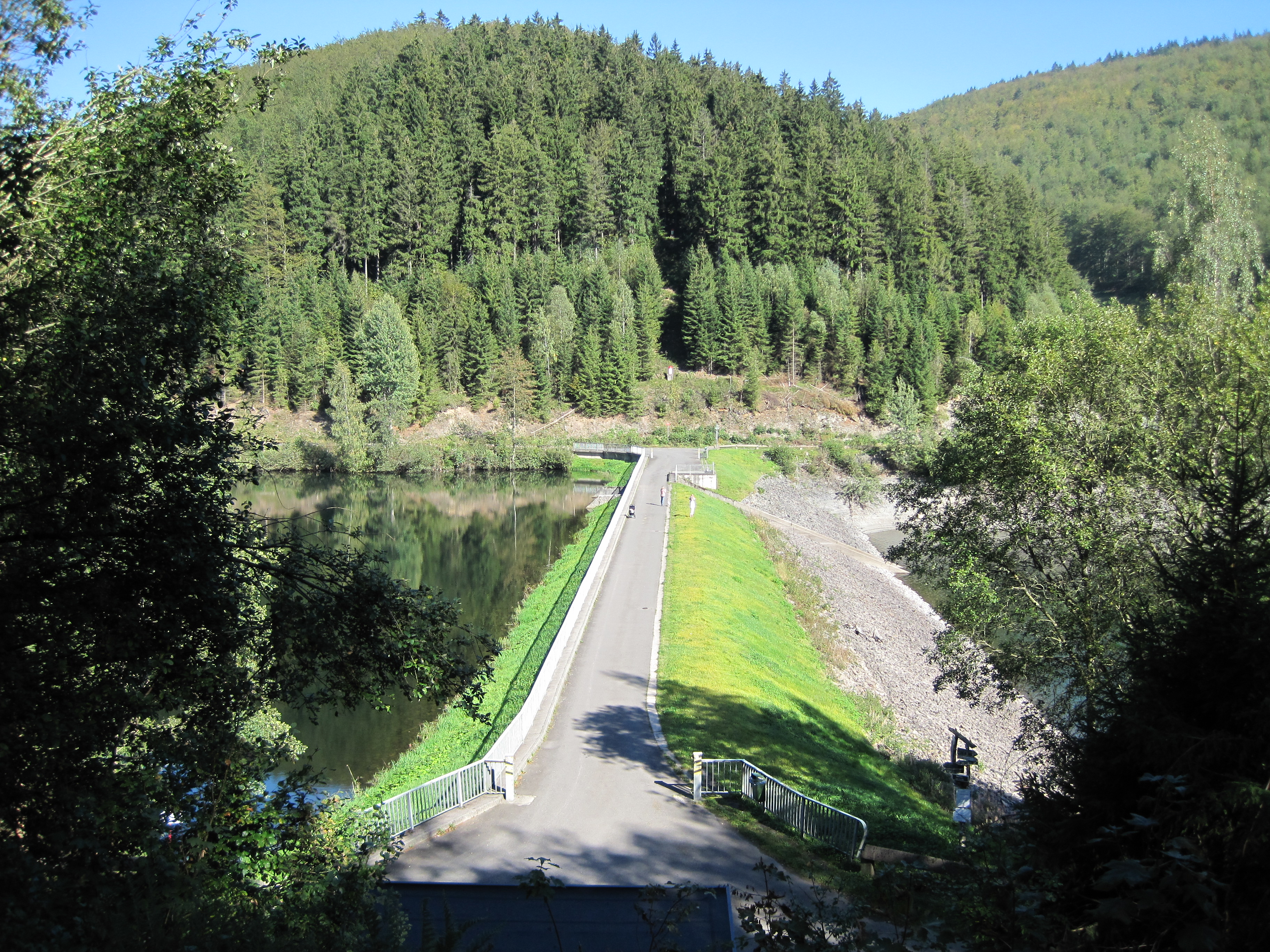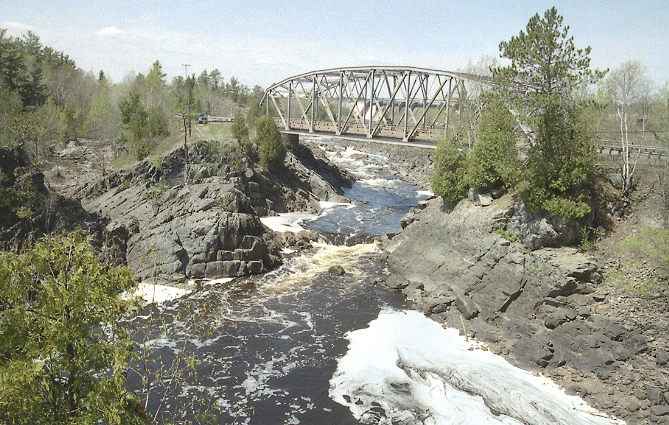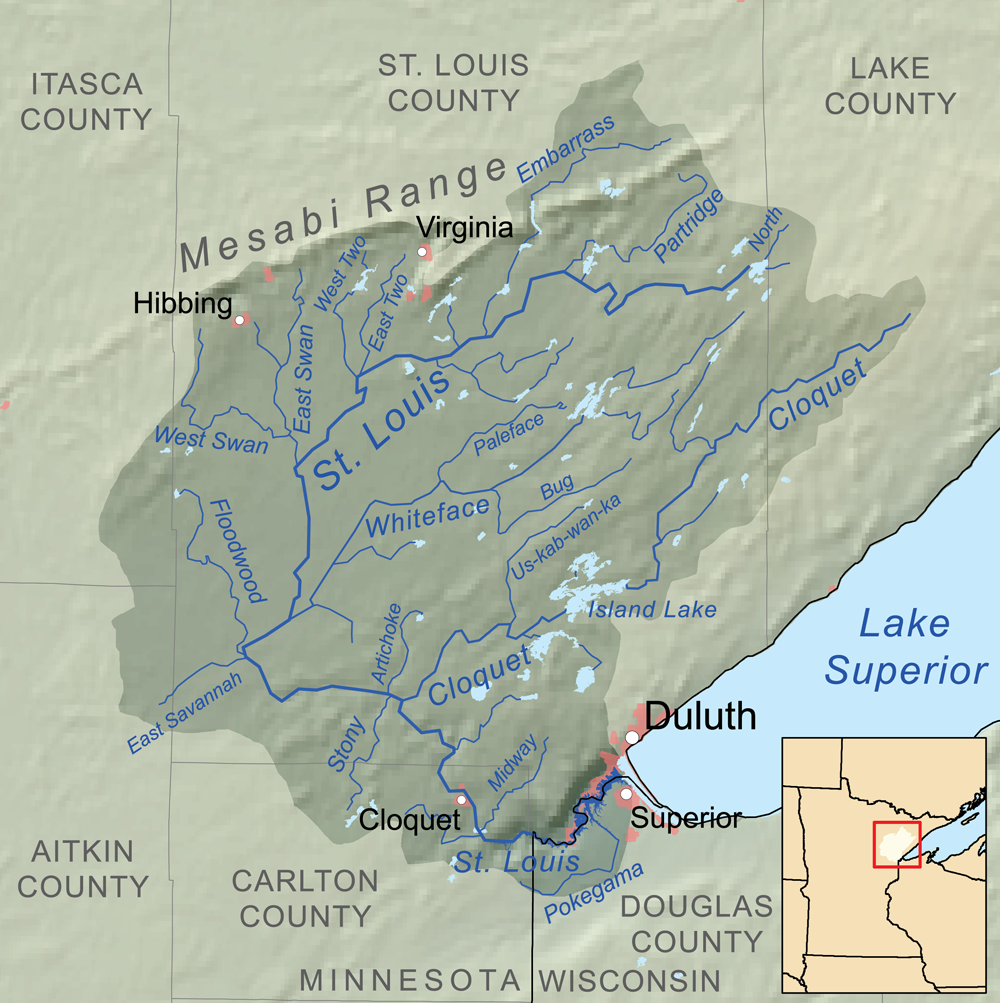|
Thomson Dam (Minnesota)
Thomson Dam, also known as the Thomson Hydro Station or Thomson Water Project, is an embankment and concrete gravity dam on the Saint Louis River near the town of Thomson in northeastern Minnesota, United States. It consists of a 1600-foot (488 m) long primary structure and multiple supplementary dams which, together with precambrian rock outcrops known as the Thomson formation, impound the river to create Thomson Reservoir. The tallest dam in the complex is 51.6 feet (16 m) and the longest is 3500 feet (1067 m). A series of gate houses, a canal, forebay, and underground penstocks supply a hydropower plant located 3 miles away in Jay Cooke State Park. With an installed capacity of 72 MW and an annual generation of approximately 280 GWh, the Thomson project is the largest hydroelectric facility in the state. History Thomson Dam was completed in 1907 by Great Northern Power, an operating division of the Great Northern Railway. The generating station was expanded in 1914 w ... [...More Info...] [...Related Items...] OR: [Wikipedia] [Google] [Baidu] |
Carlton County, Minnesota
Carlton County is a county in the State of Minnesota, formed in 1857. As of the 2020 census, the population was 36,207. Its county seat is Carlton. Part of the Fond du Lac Indian Reservation lies in northeastern Carlton County. Carlton County is part of the Duluth, MN- WI Metropolitan Statistical Area. Geography Carlton County lies on Minnesota's eastern edge. Its eastern boundary abuts Wisconsin. The Saint Louis River flows east-southeast through the county, discharging into Lake Superior. The Moose Horn River flows southwest through the county, discharging into the Kettle River. The Nemadji River and the South Fork Nemadji River flow east through the county, meeting a few miles east of its eastern boundary before reaching Lake Superior. The county terrain consists of low rolling hills, heavily wooded, and slopes to the several river valleys. The county's northwest corner lies at 1,329' (405m) ASL, and a small hill 0.2 miles (0.35 km) west of Rogers Lake rises to 1,4 ... [...More Info...] [...Related Items...] OR: [Wikipedia] [Google] [Baidu] |
Forebay (reservoir)
A forebay is an artificial pool of water in front of a larger body of water. The larger body of water may be natural or man-made. at www.wisegeek.com. Retrieved on 13 Jun 2013 Forebays have a number of functions. They are used in to act as a buffer during or s, impounding water and releasing in a controlled way into the larger waterbody. They may be used upstream of |
Buildings And Structures In Carlton County, Minnesota
A building, or edifice, is an enclosed structure with a roof and walls standing more or less permanently in one place, such as a house or factory (although there's also portable buildings). Buildings come in a variety of sizes, shapes, and functions, and have been adapted throughout history for a wide number of factors, from building materials available, to weather conditions, land prices, ground conditions, specific uses, prestige, and aesthetic reasons. To better understand the term ''building'' compare the list of nonbuilding structures. Buildings serve several societal needs – primarily as shelter from weather, security, living space, privacy, to store belongings, and to comfortably live and work. A building as a shelter represents a physical division of the human habitat (a place of comfort and safety) and the ''outside'' (a place that at times may be harsh and harmful). Ever since the first cave paintings, buildings have also become objects or canvasses of much artistic ... [...More Info...] [...Related Items...] OR: [Wikipedia] [Google] [Baidu] |
Hydroelectric Power Plants In Minnesota
Hydroelectricity, or hydroelectric power, is electricity generated from hydropower (water power). Hydropower supplies one sixth of the world's electricity, almost 4500 TWh in 2020, which is more than all other renewable sources combined and also more than nuclear power. Hydropower can provide large amounts of low-carbon electricity on demand, making it a key element for creating secure and clean electricity supply systems. A hydroelectric power station that has a dam and reservoir is a flexible source, since the amount of electricity produced can be increased or decreased in seconds or minutes in response to varying electricity demand. Once a hydroelectric complex is constructed, it produces no direct waste, and almost always emits considerably less greenhouse gas than fossil fuel-powered energy plants. [...More Info...] [...Related Items...] OR: [Wikipedia] [Google] [Baidu] |
Dams In Minnesota
A dam is a barrier that stops or restricts the flow of surface water or underground streams. Reservoirs created by dams not only suppress floods but also provide water for activities such as irrigation, human consumption, industrial use, aquaculture, and navigability. Hydropower is often used in conjunction with dams to generate electricity. A dam can also be used to collect or store water which can be evenly distributed between locations. Dams generally serve the primary purpose of retaining water, while other structures such as floodgates or levees (also known as dikes) are used to manage or prevent water flow into specific land regions. The earliest known dam is the Jawa Dam in Jordan, dating to 3,000 BC. The word ''dam'' can be traced back to Middle English, and before that, from Middle Dutch, as seen in the names of many old cities, such as Amsterdam and Rotterdam. History Ancient dams Early dam building took place in Mesopotamia and the Middle East. Dams were used ... [...More Info...] [...Related Items...] OR: [Wikipedia] [Google] [Baidu] |
List Of Dams And Reservoirs In Minnesota
This is a list of dams and reservoirs in the U.S. state of Minnesota and pertinent data in a sortable table. There are more than 1,250 dams in the state. Over 800 are public facilities and of these 430 are owned by the Minnesota Department of Natural Resources. This list includes the most notable structures, namely all that generate hydroelectricity, any operated by the Mississippi Valley Division of the United States Army Corps of Engineers (USACE), and all dams with reservoirs larger than 100,000 acre feet according to the USACE National Inventory of Dams Notable structures in popular recreation areas are also included, in particular those at the headwaters of the Mississippi and along the North Shore of Lake Superior. Historically significant structures as well as dams whose removal have sparked media interest are also included. Furthermore, there are many dams that have yet to be listed that call Minnesota home. List of Minnesota dams and reservoirs Data definitions ... [...More Info...] [...Related Items...] OR: [Wikipedia] [Google] [Baidu] |
United States Army Corps Of Engineers
, colors = , anniversaries = 16 June (Organization Day) , battles = , battles_label = Wars , website = , commander1 = LTG Scott A. Spellmon , commander1_label = Chief of Engineers and Commanding General of the U.S. Army Corps of Engineers , commander2 = MGbr>Richard J. Heitkamp, commander2_label = Deputy Chief of Engineers and Deputy Commanding General , commander3 = MGKimberly M. Colloton, commander3_label = Deputy Commanding General for Military and International Operations , commander4 = MGbr>William H. Graham, commander4_label = Deputy Commanding General for Civil and Emergency Operations , commander5 = COLbr>James J. Handura, commander5_label = Chief of Staff for the U.S. Army Corps of Engi ... [...More Info...] [...Related Items...] OR: [Wikipedia] [Google] [Baidu] |
Minnesota State Highway 210
Minnesota State Highway 210 (MN 210) is a state highway in west-central, central, and northeast Minnesota, which runs from North Dakota Highway 210 (ND 210) at the North Dakota state line (at Breckenridge), and continues east to its eastern terminus at its intersection with MN 23 in Duluth near the Saint Louis River. The route runs across Minnesota from west-central to northeast; connecting Fergus Falls, Brainerd, and Duluth. At the western terminus of MN 210, upon crossing the Red River, the roadway becomes ND 210 and feeds into ND 13. MN 210 is in length. Route description MN 210 serves as an east–west route in west-central, central, and northeast Minnesota between Breckenridge, Fergus Falls, Staples, Baxter, Brainerd, Carlton, and Duluth. For part of its route (), MN 210 is concurrent with US Highway 10 (US 10) between Motley and Staples in central Minnesota. The highway crosses the Washington Street ... [...More Info...] [...Related Items...] OR: [Wikipedia] [Google] [Baidu] |
Hydroelectric
Hydroelectricity, or hydroelectric power, is electricity generated from hydropower (water power). Hydropower supplies one sixth of the world's electricity, almost 4500 TWh in 2020, which is more than all other renewable sources combined and also more than nuclear power. Hydropower can provide large amounts of low-carbon electricity on demand, making it a key element for creating secure and clean electricity supply systems. A hydroelectric power station that has a dam and reservoir is a flexible source, since the amount of electricity produced can be increased or decreased in seconds or minutes in response to varying electricity demand. Once a hydroelectric complex is constructed, it produces no direct waste, and almost always emits considerably less greenhouse gas than fossil fuel-powered energy plants. [...More Info...] [...Related Items...] OR: [Wikipedia] [Google] [Baidu] |
Megawatt
The watt (symbol: W) is the unit of Power (physics), power or radiant flux in the International System of Units, International System of Units (SI), equal to 1 joule per second or 1 kg⋅m2⋅s−3. It is used to quantification (science), quantify the rate of Energy transformation, energy transfer. The watt is named after James Watt (1736–1819), an 18th-century Scottish people, Scottish invention, inventor, mechanical engineer, and chemist who improved the Newcomen steam engine, Newcomen engine with his own Watt steam engine, steam engine in 1776. Watt's invention was fundamental for the Industrial Revolution. Overview When an object's velocity is held constant at one metre per second against a constant opposing force of one Newton (unit), newton, the rate at which Work (physics), work is done is one watt. : \mathrm In terms of electromagnetism, one watt is the rate at which electrical work is performed when a current of one ampere (A) flows across an electrical potentia ... [...More Info...] [...Related Items...] OR: [Wikipedia] [Google] [Baidu] |
Jay Cooke State Park
Jay Cooke State Park is a state park of Minnesota, United States, protecting the lower reaches of the Saint Louis River. The park is located about southwest of Duluth and is one of the ten most visited state parks in Minnesota. The western half of the park contains part of a rocky, gorge. This was a major barrier to Native Americans and early Europeans traveling by canoe, which they bypassed with the challenging Grand Portage of the St. Louis River. The river was a vital link connecting the Mississippi waterways to the west with the Great Lakes to the east. Today Minnesota State Highway 210 runs through Jay Cooke State Park. The of the route between Carlton and Highway 23—which include the park—are designated the Rushing Rapids Parkway, a state scenic byway. The park is named for Pennsylvania financier Jay Cooke, who had developed a nearby power plant, which is still in use. The Grand Portage trail and three districts of 1930s park structures are listed on the ... [...More Info...] [...Related Items...] OR: [Wikipedia] [Google] [Baidu] |
Hydropower
Hydropower (from el, ὕδωρ, "water"), also known as water power, is the use of falling or fast-running water to Electricity generation, produce electricity or to power machines. This is achieved by energy transformation, converting the Potential energy, gravitational potential or kinetic energy of a water source to produce power. Hydropower is a method of sustainable energy production. Hydropower is now used principally for Hydroelectricity, hydroelectric power generation, and is also applied as one half of an energy storage system known as pumped-storage hydroelectricity. Hydropower is an attractive alternative to fossil fuels as it does not directly produce Carbon dioxide in Earth's atmosphere, carbon dioxide or other Air pollution, atmospheric pollutants and it provides a relatively consistent source of power. Nonetheless, it has economic, sociological, and environmental downsides and requires a sufficiently energetic source of water, such as a river or elevated lake. Int ... [...More Info...] [...Related Items...] OR: [Wikipedia] [Google] [Baidu] |








.jpg)